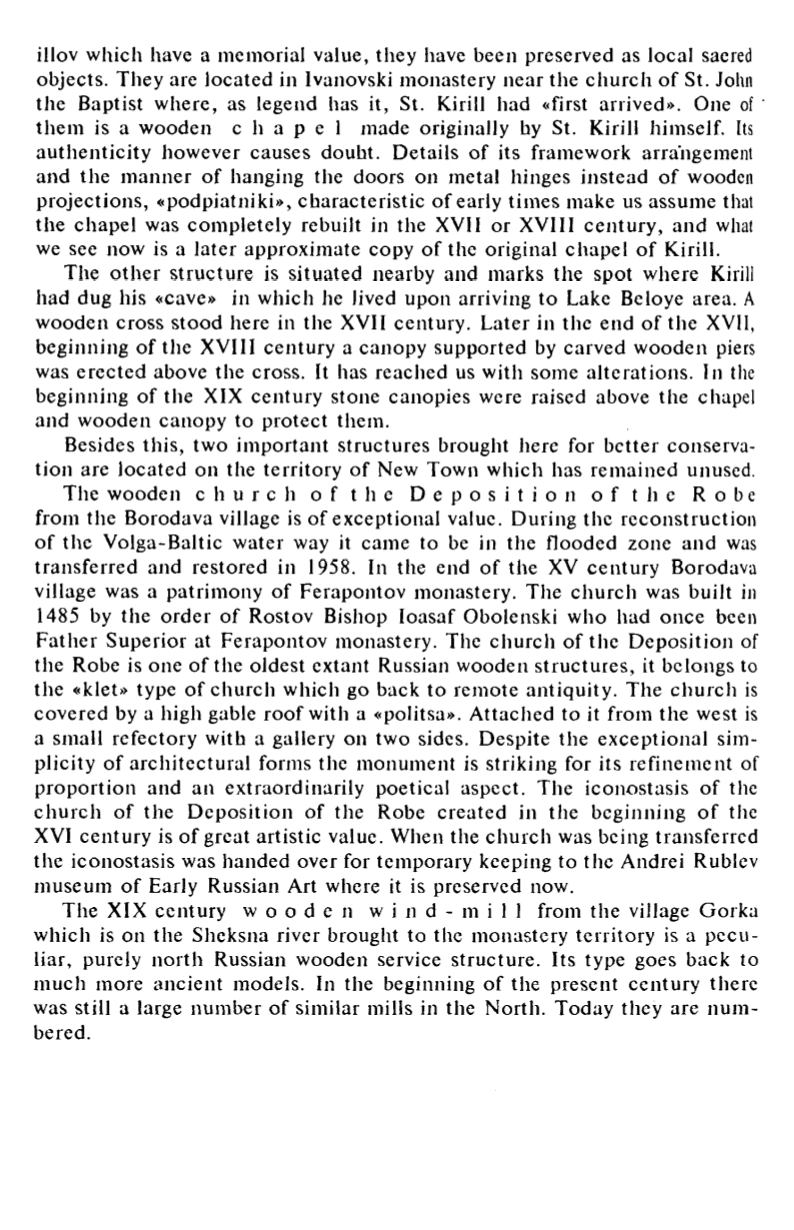

illov which have a memorial value, they have been preserved as local sacred
objects. They are located in Ivanovski monastery near the chu rch o f St. John
the Baptist where, as legend has it, St. Kirill had «first arrived». One of
them is a wooden c h a p e l made originally hy St. Kirill himself. Its
au then ticity however causes doubt. Details of its framework arrangement
and the manner of hanging the doors on metal hinges instead o f wooden
projections, «podpiatniki», characteristic o f early times make us assume that
the chapel was completely rebuilt in the XVII or XVIII century, and what
we see now is a later approximate copy o f the original chapel o f Kirill.
The o the r structure is situated nearby and marks the spot where Kirill
had dug his «cave» in which he lived upon arriving to Lake Beloye area. A
wooden cross stood here in the XVII century. Later in the end o f the XVI1,
beginning of the XVIII century a canopy supported by carved wooden piers
was erected above the cross. It has reached us with some alterations. In the
beginning of the XIX century stone canopies were raised above the chapel
and wooden canopy to protect them.
Besides this, two important structures brought here for better conserva
tion are located on the territory of New Town which has remained unused.
The wooden c h u r c h o f t h e D e p o s i t i o n o f t h e R o b e
from the Borodava village is of exceptional value. During the reconstruction
o f the Volga-Baltic water way it came to be in the flooded zone and was
transferred and restored in 1958. In the end o f the XV cen tury Borodava
village was a patrimony of Ferapontov monastery. The chu rch was built in
1485 by the order o f Rostov Bishop Ioasaf Obolenski who had once been
Father Superior at Ferapontov monastery. The church of the Deposition of
the Robe is one o f the oldest extant Russian wooden structures, it belongs to
the «klet» type o f church which go back to remote antiquity. The chu rch is
covered by a high gable roof with a «politsa». Attached to it from the west is
a small refectory with a gallery on two sides. Despite the exceptional sim
plicity of a rch itectural forms the monument is striking for its refinement of
proportion and an extraordinarily poetical aspect. The iconostasis of the
chu rch of the Deposition of the Robe created in the beginning o f tlie
XVI century is o f great artistic value. When the chu rch was being transferred
the iconostasis was handed over for temporary keeping to the Andrei Rublev
museum o f Early Russian Art where it is preserved now.
The XIX century w o o d e n w i n d - m i 1 1 from the village Gorka
which is on the Shcksna river brought to the monastery territory is a p e c u
liar, purely no rth Russian wooden service structure. Its type goes back to
much more ancient models. In the beginning o f the present century there
was still a large number o f similar mills in the North. Today they are n um
bered.















